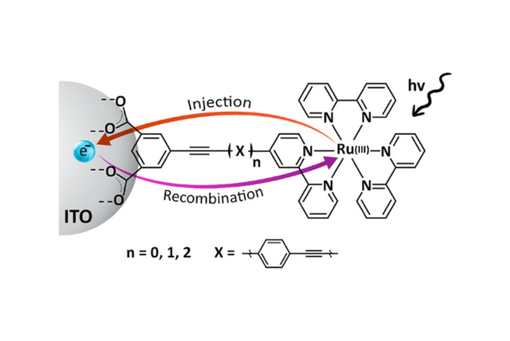Reorganization Energies for Interfacial Electron Transfer across Phenylene Ethynylene Rigid-Rod Bridges
Abstract
A family of three ruthenium bipyridyl rigid-rod compounds of the general form [Ru(bpy)2(LL)](PF6)2 were anchored to mesoporous thin films of tin-doped indium oxide (ITO) nanocrystals. Here, LL is a 4-substituted 2,2-bipyridine (bpy) ligand with varying numbers of conjugated phenylenethynylene bridge units between the bipyridine ring and anchoring group consisting of a bis-carboxylated isophthalic group. The visible absorption spectra and the formal potentials, Eo(RuIII/II), of the surface anchored rigid-rods were insensitive to the presence of the phenylene ethynylene bridge units in 0.1 M tetrabutyl ammonium perchlorate acetonitrile solutions (TBAClO4/CH3CN). The conductive nature of the ITO enabled potentiostatic control of the Fermi level and hence a means to tune the Gibbs free energy change, −ΔG°, for electron transfer from the ITO to the rigid-rods. Pseudo-rate constants for this electron transfer reaction increased as the number of bridge units decreased at a fixed −ΔG°. With the assumption that the reorganization energy, λ, and the electronic coupling matrix element, Hab, were independent of the applied potential, rate constants measured as a function of −ΔG° and analyzed through Marcus–Gerischer theory provided estimates of Hab and λ. In rough accordance with the dielectric continuum theory, λ was found to increase from 0.61 to 0.80 eV as the number of bridge units was increased. In contrast, Hab decreased markedly with distance from 0.54 to 0.11 cm–1, consistent with non-adiabatic electron transfer. Comparative analysis with previously published studies of bridges with an sp3-hybridized carbon indicated that the phenylene ethynylene bridge does not enhance electronic coupling between the oxide and the rigid-rod acceptor. The implications of these findings for practical applications in solar energy conversion are specifically discussed.
Citation
Reorganization Energies for Interfacial Electron Transfer across Phenylene Ethynylene Rigid-Rod Bridges
Marzieh Heidari, Quentin Loague, Rachel E. Bangle, Elena Galoppini, and Gerald J. Meyer
ACS Applied Materials & Interfaces 2022 14 (30), 35205-35214
DOI: 10.1021/acsami.2c07151


